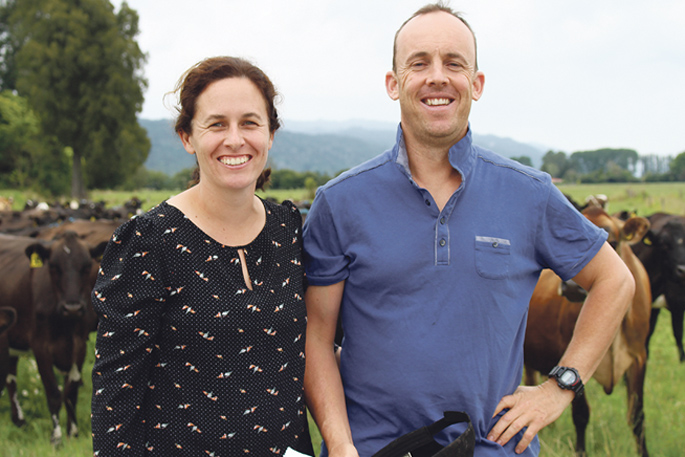Fraser McGougan has seen many farmers lose interest with dairying. He’s not one of them. He and wife Katherine purchased his family’s farm in 2011 following a succession plan instigated with foresight by parents Gavin and Charlotte McGougan. Now – having spent the last seven years paying down debt and improving profitability on-farm – they are more focused than ever on the dairy industry.
And while their vision remains clear that the 430 crossbred cow twice-a-day milking operation on 137ha effective near Whakatane remains profitable, Fraser is also implementing changes on-farm that will benefit the environment.
“We started with 270 cows on the home farm and added more cows as we acquired more land. As a young farming couple we’ve done a fair bit of benchmarking, now we’re trying to find out where we sit environmentally.”
And recent years have brought a change in focus “into looking at environmental best practice and how the farm can still be sustainable, viable and economic in 100 years’ time”.
“Our mentality has changed – we now think that we look after the land and it looks after us.”
As a fourth-generation farmers of the property, Fraser says they’re looking to the future. “I want our farm to be seen as an example of what can be done on a pretty standard farm, while balancing profitability and environmental standards. Small steps now lead to big differences down the track.”
In their first year owning the business they created a 34-bail rotary by retrofitting an old platform made for 28 cows. Since then they’ve installed technology to improve milking efficiency and save on water and power use.
“We’ve put in automatic cup removers, bail restraints, automated teat spray, compressed air to purge the milk lines so you require water. We’ve also installed a heat recovery unit and snap-chilling for milk cooling.
“I did the milking for seven years solid; now I have two staff it’s about making the one-person shed a nice work environment for them,” says Fraser.
Freshwater is re-used at the cowshed up to three times. “When water enters the shed its first use is for pre-cooling milk – then it is re-used to wash-down the plant and from there is pumped to a tank for floodwash.”
“This keeps our effluent storage requirements down and reduces the amount you need to irrigate. It means you use less fresh water and you have less effluent water to get rid of. A guesstimate is it halves our water use at the cowshed.”
The farm also has an increasing area under effluent irrigation. “We have 36ha. Very shortly this will climb to 42ha – with 420 cows. This saves us on purchasing nutrients.”
In fertiliser application, Fraser has focused on precision farming using nutrients smarter to encourage grass-growth.
“Nitrogen has a bell curve for its use, so we believe it’s better to use 23 units or 50kg of urea per application – if we do use it. After that you’re just diminishing returns.”
The McGougans have also purchased a spreader to time applications right. “And we’ve invested in a GPS tracking system for our tractors so we can achieve accurate application.”
Fraser says the right timing – and putting the right nutrients on in the right place brings results. “You decrease N use and application costs but you grow more grass. I’ve done the numbers on it and it really stacks up.”
Recently, Fraser has contracted individual paddock soil sampling. He says it’s an initial expense but makes a huge difference in saving on total fertiliser spend and time. And it’s really eye-opening.
“We put different rates of fertiliser on different paddocks. Sampling has shown some paddocks have high Olsen Ps and don’t need fertiliser for two-three years. At some stage we’ll break our paddocks down into areas too.”
The farm has a small amount of native bush, including an impressive stand of kahikatea trees. “My father fenced this piece off, now with Katherine and the children, Emily, 7, Isaac, 5, and Liam, 2, we’re going through a regenerative process controlling weeds and pests. Another piece of land we bought has trees, so we’re retiring the land, fencing it off and replanting natives.”
Fraser says while its sounds like they invest lots, he insists they’ve been smart investments that serve to increase profitability on-farm and the environment.
In 2016 they won Best People Leadership in the Dairy Business of the Year awards, plus Low Input with Best Financials and Best BOP-Central Plateau Farm Performance.
“The quote thrown is: ‘You’ve got to be black to be green’. But it does make sense – and it helps that Katherine is a whiz with the accounts and strategic planning.”
In May 2018 Fraser was named one of 15 climate change ambassadors, the only farmer from the BOP. He’s now on an 18-month commitment to champion the climate change cause as part of the Dairy Action for Climate Change.
“With climate change I believe there’s something which is happening, and we’re going to make a difference and we’re going to make a positive change for our world.
“As an ambassador I’m learning so much information on this topic and trying to filter it through to our farming communities.”
“At the start I had no experience – but I think I provide different points of view and enthusiasm and it’s neat talking about issues to ministers but also portraying what issues us farmers have. Because it’s not all one-sided.
“Our farm floods badly and also gets really hot, so we don’t have perfect dream farm. So we have to work with the environment – not against it.”
And the dairy industry offers so much opportunity today to make difference, says Fraser. “It’s not just cows and grass anymore. It’s much bigger than that. It’s more fun, more complicated, and more engaging.”



0 Comments
Leave a Comment